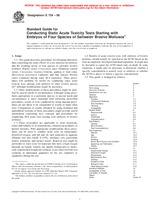Potřebujeme váš souhlas k využití jednotlivých dat, aby se vám mimo jiné mohly ukazovat informace týkající se vašich zájmů. Souhlas udělíte kliknutím na tlačítko „OK“.
ASTM E724-98
Standard Guide for Conducting Static Acute Toxicity Tests Starting with Embryos of Four Species of Saltwater Bivalve Molluscs
Automaticky přeložený název:
Standardní Příručka pro vedení statické akutní toxicity Zkoušky Počínaje s embryi čtyř druhů slané vody mlžů
NORMA vydána dne 10.10.1998
Informace o normě:
Označení normy: ASTM E724-98
Poznámka: NEPLATNÁ
Datum vydání normy: 10.10.1998
Kód zboží: NS-47802
Počet stran: 21
Přibližná hmotnost: 63 g (0.14 liber)
Země: Americká technická norma
Kategorie: Technické normy ASTM
Anotace textu normy ASTM E724-98 :
Keywords:
Acute toxicity tests, Biological data analysis, Bivalve molluscs embryos/larvae, Blue mussel, Chemical analysis-water applications, Crassostrea gigas, Crassostrea virginic, Eastern oyster, Embryos, Exposure tests, Fresh water, Hardclam, Larvae, Mercenaria mercenaria, Molluscs, Mussel, Mytilus edulis, Oyster, Pacific oyster, Quahog, Saltwater, Spatula rub-out test, Spawning, Toxicity/toxicology-water environments, conducting static acute toxicity tests with embryos/larvae of four
Doplňující informace
| 1. Scope | ||||||||||||||||
|
1.1 This guide describes procedures for obtaining laboratory data concerning the acute effects of a test material on embryos and the resulting larvae of four species of saltwater bivalve molluscs (Pacific oyster, Crassostrea gigas Thunberg; eastern oyster, Crassostrea virginica Gmelin; quahog or hard clam, Mercenaria mercenaria Linnaeus; and blue mussel, Mytilus edulis Linnaeus) during static 48-h exposures. These procedures will probably be useful for conducting static acute toxicity tests starting with embryos of other bivalve species (1) although modifications might be necessary. 1.2 Other modifications of these procedures might be justified by special needs or circumstances. Although using procedures appropriate to a particular species or special needs and circumstances is more important than following prescribed procedures, results of tests conducted by using unusual procedures are not likely to be comparable to results of many other tests. Comparison of results obtained by using modified and unmodified versions of these procedures might provide useful information concerning new concepts and procedures for conducting 48-h acute tests starting with embryos of bivalve molluscs. 1.3 These procedures are applicable to most chemicals, either individually or in formulations, commercial products, or known mixtures. With appropriate modifications these procedures can be used to conduct acute tests on temperature, dissolved oxygen, and pH and on such materials as aqueous effluents (see also Guide E1192), leachates, oils, particulate matter, sediments, and surface waters. Renewal tests might be preferable to static tests for materials that have a high oxygen demand, are highly volatile, are rapidly biologically or chemically transformed in aqueous solution, or are removed from test solutions in substantial quantities by the test chambers or organisms during the test. 1.4 Results of acute toxicity tests with embryos of bivalve molluscs should usually be reported as the EC50 based on the total incompletely developed and dead organisms. It might also be desirable to report the LC50 based only on death. In some situations, it might only be necessary to determine whether a specific concentration is acutely toxic to embryos or whether the EC50 is above or below a specific concentration. 1.5 This guide is arranged as follows: Section Referenced Documents 2 Terminology 3 Summary of Standard 4 Significance and Use 5 Apparatus 6 Facilities 6.1 Construction Materials 6.2 Test Chambers 6.3 Cleaning 6.4 Acceptability 6.5 Hazards 7 Dilution Water 8 Requirements 8.1 Source 8.2 Treatment 8.3 Characterization 8.4 Test Material 9 General 9.1 Stock Solution 9.2 Test Concentration(s) 9.3 Test Organisms 10 Species 10.1 Age 10.2 Source 10.3 Handling 10.4 Brood Stock Source and Condition 10.5 Spawning and Fertilization 10.6 Quality 10.7 Procedure 11 Experimental Design 11.1 Dissolved Oxygen 11.2 Temperature 11.3 Beginning the Test 11.4 Feeding 11.5 Duration of Test 11.6 Biological Data 11.7 Other Measurements 11.8 Analytical Methods 12 Acceptability of Test 13 Calculation of Results 14 Report 151.6 This standard does not purport to address all of the safety concerns, if any, associated with its use. It is the responsibility of the user of this standard to establish appropriate safety and health practices and determine the applicability of regulatory limitations prior to use. Specific hazard statements are given in Section 6. |
||||||||||||||||
| 2. Referenced Documents | ||||||||||||||||
|




 Cookies
Cookies
